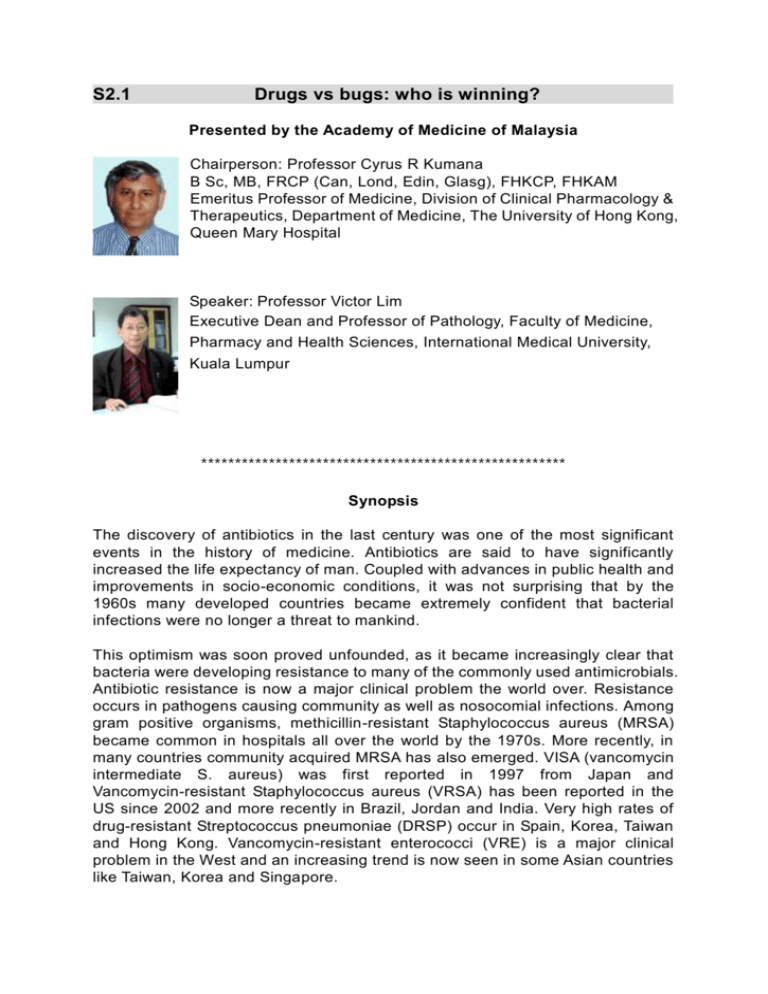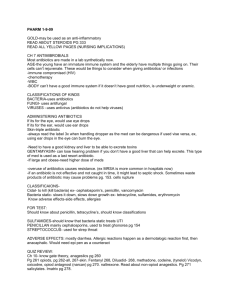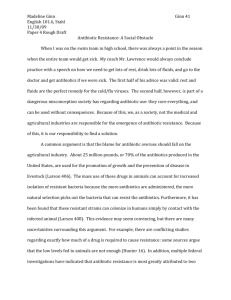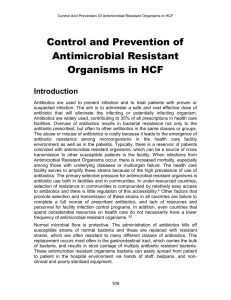Drugs vs bugs: who is winning?
advertisement

S2.1 Drugs vs bugs: who is winning? Presented by the Academy of Medicine of Malaysia Chairperson: Professor Cyrus R Kumana B Sc, MB, FRCP (Can, Lond, Edin, Glasg), FHKCP, FHKAM Emeritus Professor of Medicine, Division of Clinical Pharmacology & Therapeutics, Department of Medicine, The University of Hong Kong, Queen Mary Hospital Speaker: Professor Victor Lim Executive Dean and Professor of Pathology, Faculty of Medicine, Pharmacy and Health Sciences, International Medical University, Kuala Lumpur ****************************************************** Synopsis The discovery of antibiotics in the last century was one of the most significant events in the history of medicine. Antibiotics are said to have significantly increased the life expectancy of man. Coupled with advances in public health and improvements in socio-economic conditions, it was not surprising that by the 1960s many developed countries became extremely confident that bacterial infections were no longer a threat to mankind. This optimism was soon proved unfounded, as it became increasingly clear that bacteria were developing resistance to many of the commonly used antimicrobials. Antibiotic resistance is now a major clinical problem the world over. Resistance occurs in pathogens causing community as well as nosocomial infections. Among gram positive organisms, methicillin-resistant Staphylococcus aureus (MRSA) became common in hospitals all over the world by the 1970s. More recently, in many countries community acquired MRSA has also emerged. VISA (vancomycin intermediate S. aureus) was first reported in 1997 from Japan and Vancomycin-resistant Staphylococcus aureus (VRSA) has been reported in the US since 2002 and more recently in Brazil, Jordan and India. Very high rates of drug-resistant Streptococcus pneumoniae (DRSP) occur in Spain, Korea, Taiwan and Hong Kong. Vancomycin-resistant enterococci (VRE) is a major clinical problem in the West and an increasing trend is now seen in some Asian countries like Taiwan, Korea and Singapore. Among gram-negative organisms, the extended spectrum betalactamase (ESBL) producers are a significant problem in hospitals. ESBL-producing Klebsiella pneumoniae strains are commonly encountered in many countries in this region including Malaysia, Singapore, Philippines, Taiwan and Indonesia. Among other nosocomial pathogens resistant to traditional agents, Acinetobacter baumannii and Pseudomonas aeruginosa also pose significant therapeutic challenges. Strains of these organisms are now resistant to all antibiotics with the exception of polymyxin. Among community acquired gram-negative infections quinolone resistance is now encountered among Campylobacter sp and Salmonella enterica serotypes, including Salmonella enterica serovar Typhi. Reasons for these high rates of antibiotic resistance are varied and complex. In general there is overuse of antibiotics as evidenced by antibiotic prescribing surveys. There is also a lack of awareness among doctors on the need for rational use. In many less developed nations there is minimal access to infectious diseases clinicians, medical microbiologists or microbiology laboratory facilities. Infection control standards are deficient in many hospitals thus promoting spread of resistant organisms. Lack of appropriate legislation or poor enforcement of existing legislation in some countries has resulted in sales of over-the-counter antibiotics and self-prescribing. Use of antibiotics in animal husbandry is also largely uncontrolled. More recent evidence also suggests that resistant organisms had occurred in nature for a very long time, even before the advent of antibiotics. Is the discovery of new antibiotics keeping pace with the emergence of resistance? Sadly the answer has to be no. Only 2 new classes have been discovered in recent decades and both are primarily anti-gram positive. Technologies like combinatorial chemistry and high through-put screening which held great promise a few decades ago, have not achieved what had been expected. The pharmaceutical industry is unwilling to invest heavily in antimicrobial research, claiming that returns are not sufficiently lucrative. Antibiotics are only taken for short periods and to make the investments worthwhile they have to be priced very expensively, which is impractical. It makes much better business sense to invest in lipid lowering agents, anti-hypertensives or anti-diabetics that are taken by patients life-long. There has been limited success in finding new agents among existing classes of antibiotics eg tigecycline, a tetracycline analogue with promising activity against Gram-positives and Acinetobacter. The use of inhibitor agents against bacterial resistance mechanisms is another strategy (e.g. use of β-lactamase inhibitor/β-lactam combinations). New formulations of old agents can also overcome resistance to a certain extent, by exploiting their pharmacokinetic and pharmacodynamic properties. There is also a need to put in place various strategies to limit antibiotic resistance. In particular, it is imperative to improve surveillance of antibiotic resistance in hospitals as well as the community. Education of both prescribers and consumers is vital. Practical antibiotic policies should be implemented at institutional and if possible at national levels. More resources should be made available for laboratory infrastructure and training of appropriate personnel to improve accuracy and timeliness of microbiological laboratory tests. There is also an urgent need to upgrade infection control standards in hospitals. Relevant legislation should be introduced to minimize unrestricted sales of antibiotics and self-prescription as well as to control their non-medical use. Failure to do so will result in dire consequences for the world. It appears that microorganisms are winning this war.






